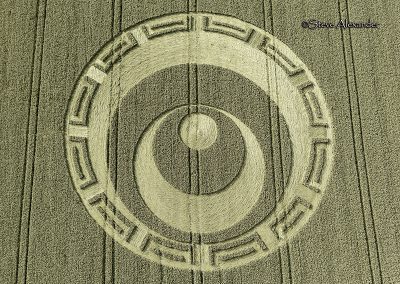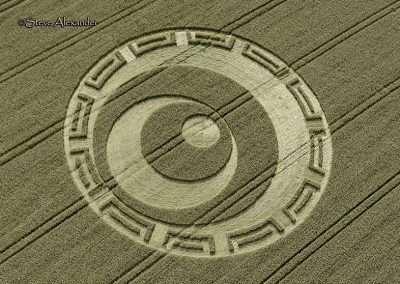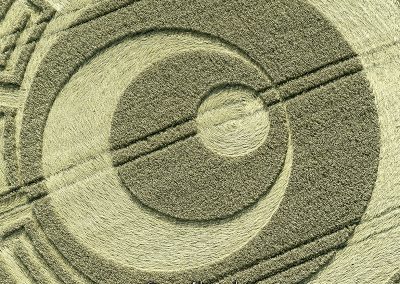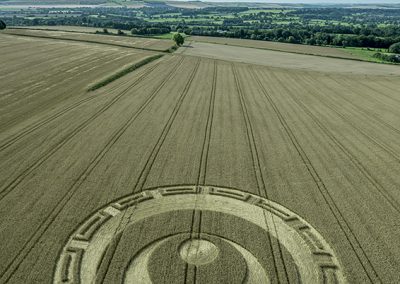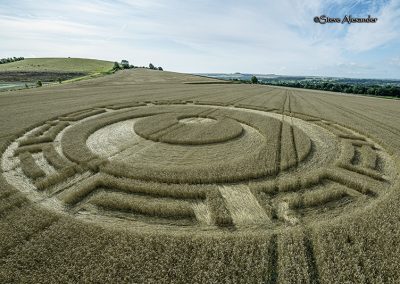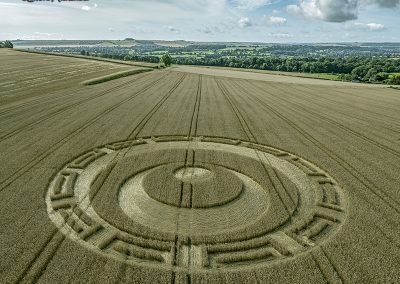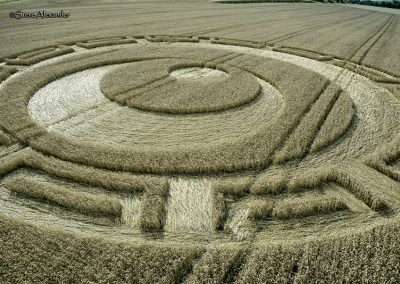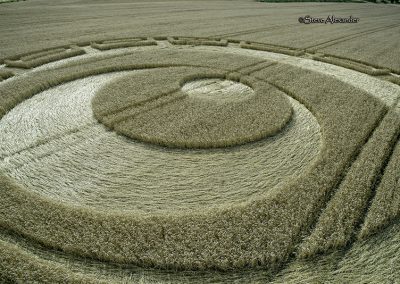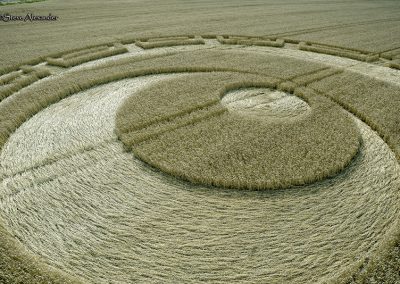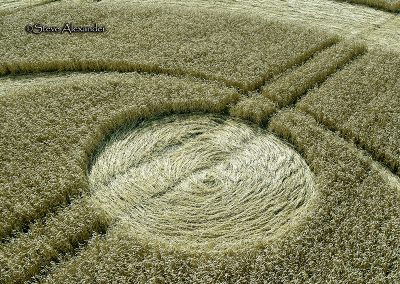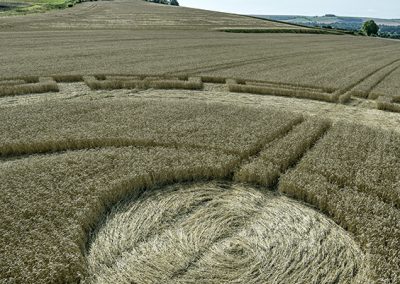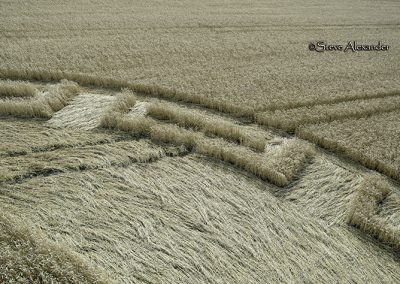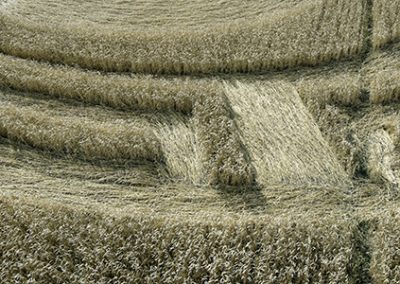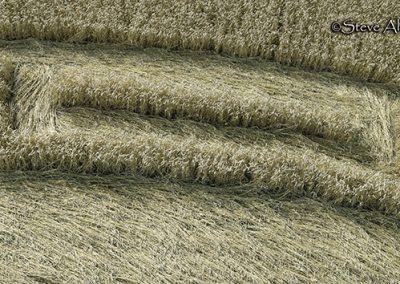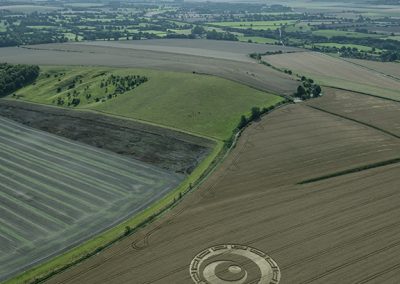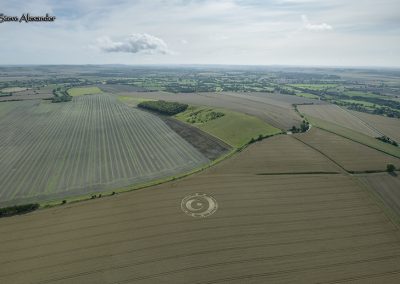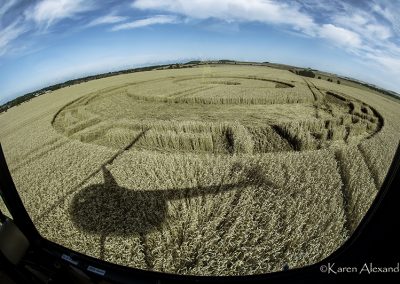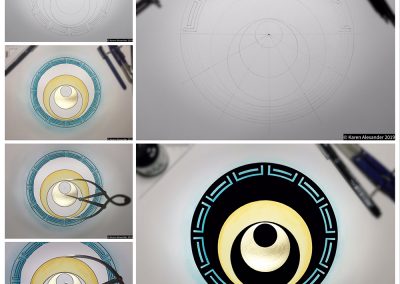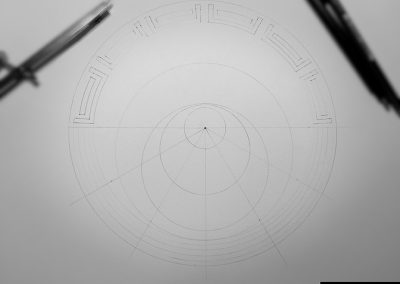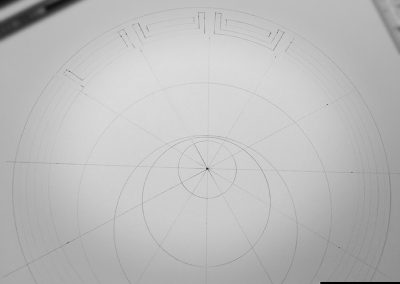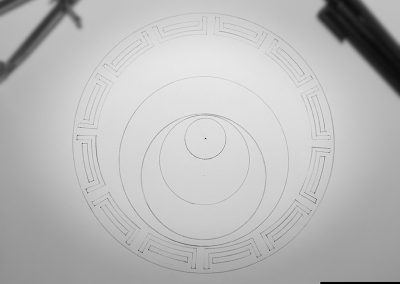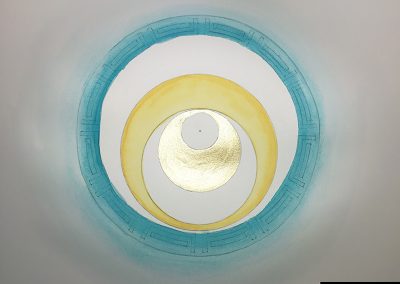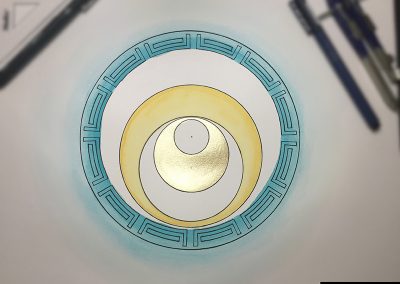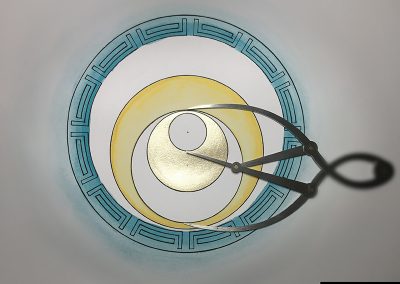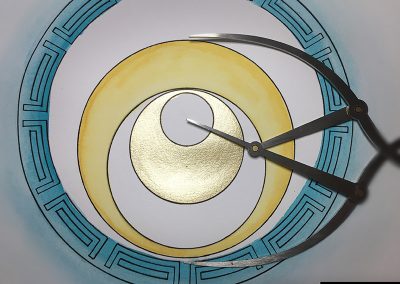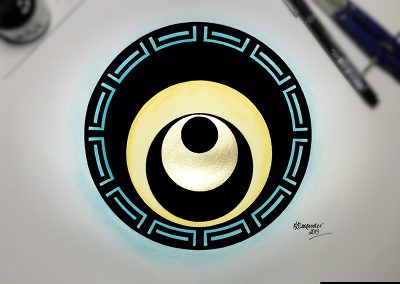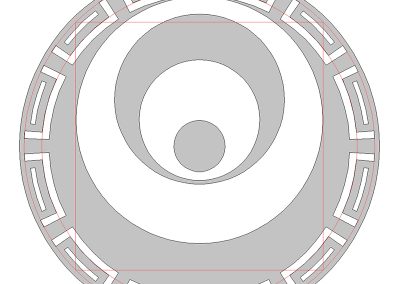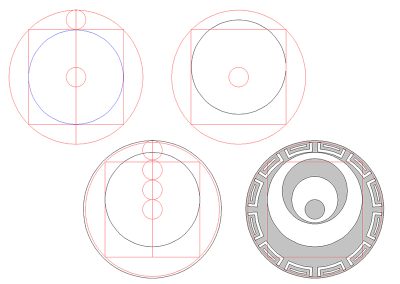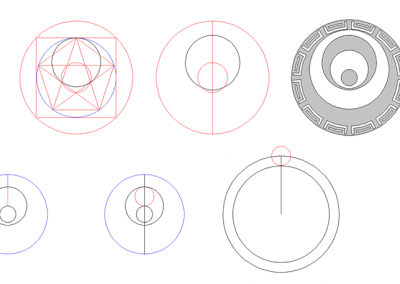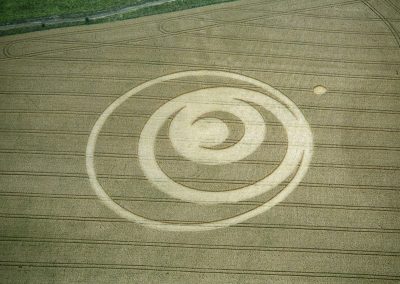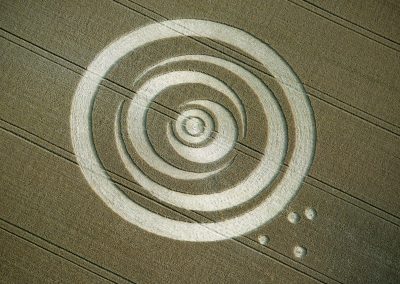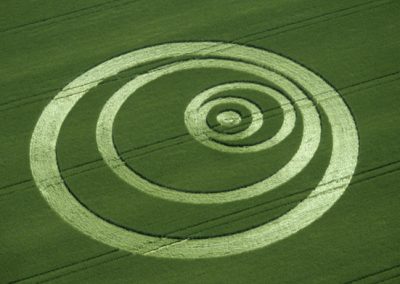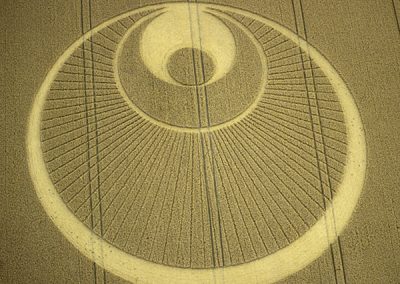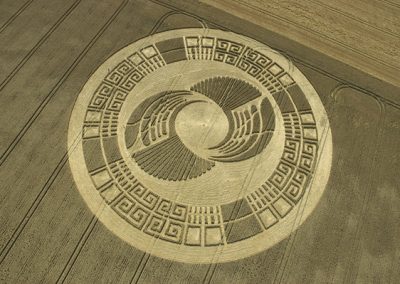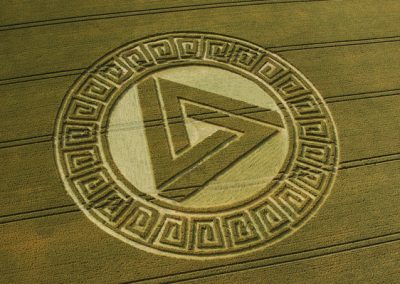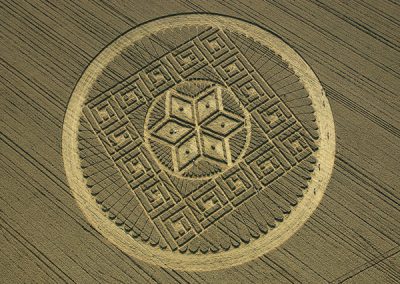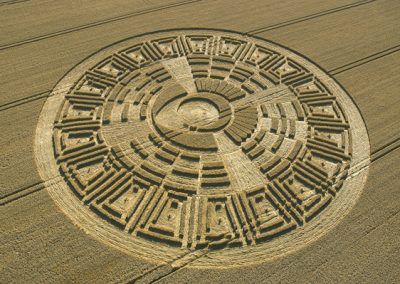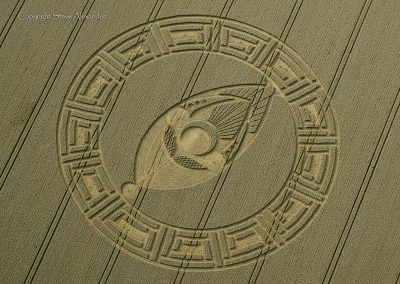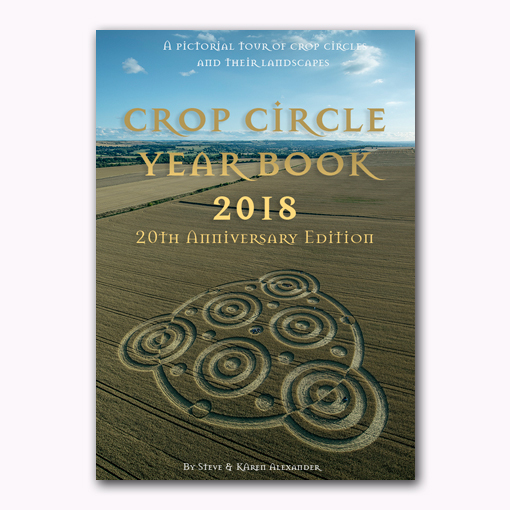Etchilhampton, Wiltshire.
Detail & Location: This circle was reported on the 20th of August and is in a field of golden wheat. It measures approximately 200ft in diameter. The circle is not far from the A342 where it passes Monument Hill.
Visiting: This crop circle has now been harvested. The farmer was allowing access to this formation. Donations for the farmer can be left at the Honeystreet Mill Cafe, near Alton Barnes. This formation has now been harvested.
History & Connections: Etchilhampton has been a crop circle location for many, many years, right back to the very early 1990s. There was a huge and beautiful circle nearby here (at Mixon) last year at the end of the season. In recent years it seems that Etchilhampton Hill has become a regular home to circles appearing very late in the season. While this circle was not in anyway as large or complex as the 2018 Mixon circle, it was pretty on the landscape.
Design & Symbolism: This circle didn’t break any new geometrical ground, but rather recycled design motifs we have seen many times before. A set of nested crescents make up the central part of the design, with twelve box-type motifs around its perimeter. We have seen nested crescents appearing since the early nineties and the stylised-boxes (as a bounding perimeter) since 2005. Sometimes these boxes are spirals, but the boxes in this circle could perhaps be interpreted as partial spirals? Funnily enough the nested crescents look a little like an angel singing!
See the Geometry Gallery below for some other circles with similar design features and check back on this page for a full geometry write-up and drawings very soon.
Visiting the Circles? If you are thinking of visiting any crop circles this summer, please read our Visiting the Crop Circles section. It’s full of useful information and etiquette for visiting the countryside and the crop circles. Please remember that you should not enter any fields without the express permission of the farmer.
Click here for Copyright Information about the reproduction of images on this website.
Please Help to keep us Flying in 2019: If you have enjoyed looking at our pictures and information please consider making a small donation to keep us flying. There are so few of us left regularly recording the circles it’s really important that we continue. And while some now use drones to record the circles, it is important that there are still images taken from aircraft where the best quality camera equipment can be used and images that include the broad vista of the landscape can be taken. This kind of photography is expensive and it gets harder with each passing year to raise the funds we need to continue our work, but if everyone who regularly looked at this website made a small donation we would meet the funds we need. You can make a donation here.
NOTE: Some of the images below are beautiful landscape scenes. Click on each image to enlarge them and see the whole picture.
Image Licencing
We can supply high resolution images of many of our photographs and the sky is the limit as to what they can be used for! Choose from our extensive library or contact us to commission aerial photography for your project.
Geometry Gallery
Sun, Moon & the Whole of Humanity
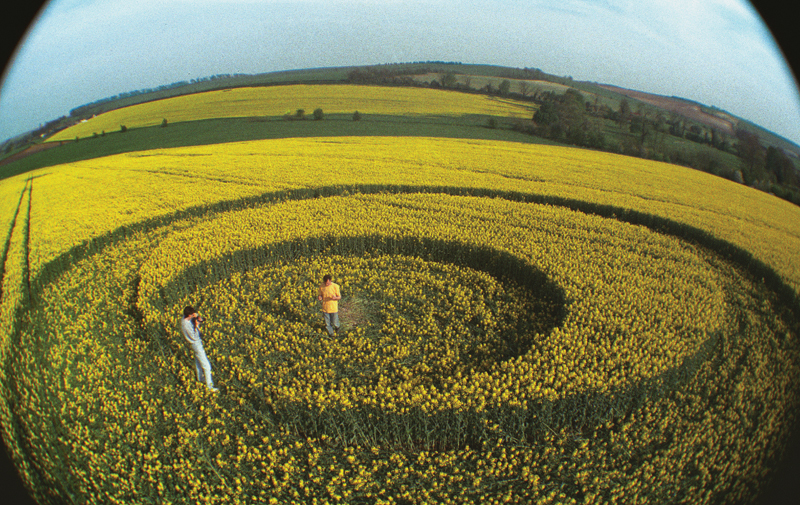
The Sanctuary 1994 – the first crescent moon?
The origins for the design of this circle can be traced at least as far back as 1994 when a ringed crescent moon appeared in a field of oilseed rape (canola) next to the Sanctuary – a small stone circle, part of the Avebury complex. As far as I recall this was the first time we had seen this particular motif. The crescent moon reoccurred throughout the 1994 season in various forms and iterations, it has been with us ever since. I have added some ‘crescent’ formations in the picture gallery below.
The geometry of this type of crescent (Fig.1) involves two or more circles, one smaller than the other. Each circle is centred on the same axis, but their locations are not the same. Often the perimeters of these circles touch , but not always, and there can then be several circles of different sizes in the same formation creating a nest of crescents – or ‘nested crescent’ design. In the crescent at the Sanctuary (above) the crescent moon is further surrounded by another flattened circle to create a containing boundary around it. Sometimes the perimeter of one circle can be the centre of another, there have been many variations on this theme in the intervening 25 years.
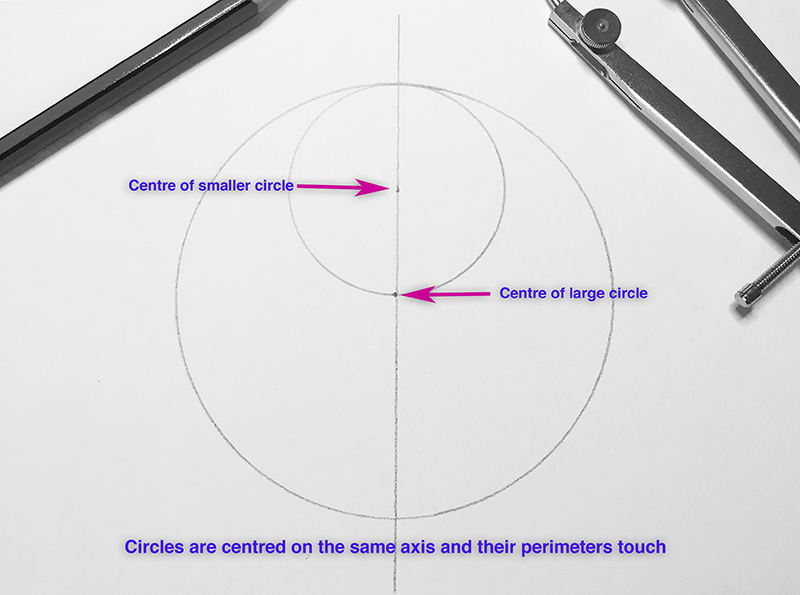
Fig 1. The geometry of the crescent moon motif.
There was a particularly nice set of crescent moons below Oliver’s Castle in 1994 and the Angel of 2001 also made use of this kind of geometry – both are in the gallery below.
The marrying of circles in this way locks together the circle and the crescent moon – or the Sun and Moon. This is a simple, yet powerful symbol of the Heiros Gamos – the Sacred Marriage, or union of the opposites – the conjunction of which we see in the sky during a solar eclipse. The marriage of opposites seems a fundamental part of crop circle design, whether it is in this way, or in the the Squaring of the Circle (the marriage of the circle and square) representing the opposites. At their most basic level, for the most part, crop circles are a marriage of standing and flattened wheat. All this points to an underlying theme of equality, harmony and integration.
In this circle at Etchilhampton, there are 4 circles which make up the crescent moon motif in its interior, the smallest of which also marks the centre of the entire design. It’s difficult to know which way up (if any way) it is supposed to be? In the end I decided that I don’t really think it matters, it seems to work pretty much anyway. However, I did like it as it was photographed by Steve with the moons at the bottom, somehow their gravity seemed to weight and anchor the design. There were also a couple of very nice Phi proportions in this part of the crop circle design – see the gallery below for images.
Moving to the perimeter of this formation, the circle is divided into 12 to create the box-like motifs. As you will see in the pencil-line drawings in the gallery below, they are picked out from a set of fine rings just inside the perimeter of the formation – there are 5 rings required. Once again, these boxes (for want of a better description), are something we have seen before, although not exactly as seen in this formation. I have included some images in the galley for you to compare and contrast.
Twelve is a number of completion, wholeness, but is also sometimes considered the number of man – such is its ubiquity in almost every aspect of human life. Twelve measures time, space and the heavens. As a number that is easy to divide many times over, it is perfect for dividing people, land and other human domains. It is the base of many imperial measure systems and even the pre-decimal monetary system in the UK. The alignment of time, space and culture was a powerful system left over from our ancestors who saw the value in being aligned with the heavens and the cycles of time – who saw us as an integral part of a cosmic order, not set apart from it.
All in all, there are 26 standing elements in this crop circle and 4 flattened elements, giving a total of 29. There are 29 vertebrae in the human spine, giving this number a connection to higher forms of life (walking upright – if you’ll accept such a conceit). 29 is the first number that can be expressed as the sum of 3 squared numbers (2 + 3 + 4). It s also the number of years it takes the baleful planet Saturn to travel around the solar system. Finally, 29 is connected to the moon, there are usually 29 full moons in one solar year – back to the sun and moon symbolism right where we started!
While it might be said that this crop circle trod no particular new ground, it was rather beautiful and it was visited and appreciated by a great many people who were pleased to finally have a circle they could visit in the Pewsey Vale area of Wiltshire – which has been so very quiet this summer. Visiting the circles is such an important part of being involved in the phenomenon, any opportunity to do so should not be missed.
Finally, Peter van den Burg discovered that this design did indeed also square the circle and contains a hidden pentagonal proportion. Please see this diagrams in the gallery below. My grateful thanks to him, as always, for his kind sharing of his marvellous work.
Thanks/Credits:
Text | Hand-drawn Images by Karen Alexander.
Photography by Steve Alexander
With special thanks to Peter van den Burg for his thoughts, perspectives and analysis. You can see more of his great work on his Facebook page Geometry of the crop circles.


